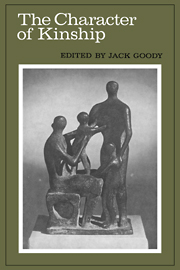Book contents
- Frontmatter
- Contents
- Dedication
- Introduction
- KINSHIP AND DESCENT
- THE NATURE OF KINSHIP
- THE NATURE OF THE FAMILY
- Kinship, Attachment Behaviour and the Primary Bond
- The Matrifocal Family
- Furies, Witches and Mothers
- MARRIAGE AND AFFINAL ROLES
- Bibliography of the Writings of Meyer Fortes
- References
- Index
The Matrifocal Family
Published online by Cambridge University Press: 07 May 2010
- Frontmatter
- Contents
- Dedication
- Introduction
- KINSHIP AND DESCENT
- THE NATURE OF KINSHIP
- THE NATURE OF THE FAMILY
- Kinship, Attachment Behaviour and the Primary Bond
- The Matrifocal Family
- Furies, Witches and Mothers
- MARRIAGE AND AFFINAL ROLES
- Bibliography of the Writings of Meyer Fortes
- References
- Index
Summary
I regard it as now established that the elementary components of patrifiliation and matrifiliation, and hence of agnatic, enatic, and cognatic modes of reckoning kinship are, like genes in the individual organism invariably present in all familial systems
(Fortes 1969: 309).…I regard the succession of generations in the process of physical and social reproduction focused in the relationships of filiation and descent as the keystone of kinship structure. For this process to go on, institutionalised forms of alliance are not essential. What is indispensable is parenthood, and for this any form of permitted procreative cohabitation is sufficient
(Fortes 1969: 308).Throughout his writings on kinship Meyer Fortes has been concerned to isolate the ‘elementary components’ of kinship and family structure. Despite careful qualification and meticulous attention to ethnographic exceptions, consistently he has found those components within the elementary family of parents and children, which more often than not constitute a domestic group, which is ‘In all human societies the workshop, so to speak, of social reproduction’ (Fortes 1958 b: 2). While he recognises evidence which shows that social placement does not always depend upon legitimate paternity, he continues to believe that patrifiliation is a universally required social attribute.
This brings us back to the proposition that no one can become a complete social person if he is not presentable as legitimately fathered as well as mothered. He must have a demonstrable pater, ideally one who is individually specified as his responsible upbringer, for he must be equipped to relate himself to other persons and to society at large bilaterally, by both matri-kinship and patri-kinship. […]
- Type
- Chapter
- Information
- The Character of Kinship , pp. 121 - 144Publisher: Cambridge University PressPrint publication year: 1974
- 3
- Cited by



